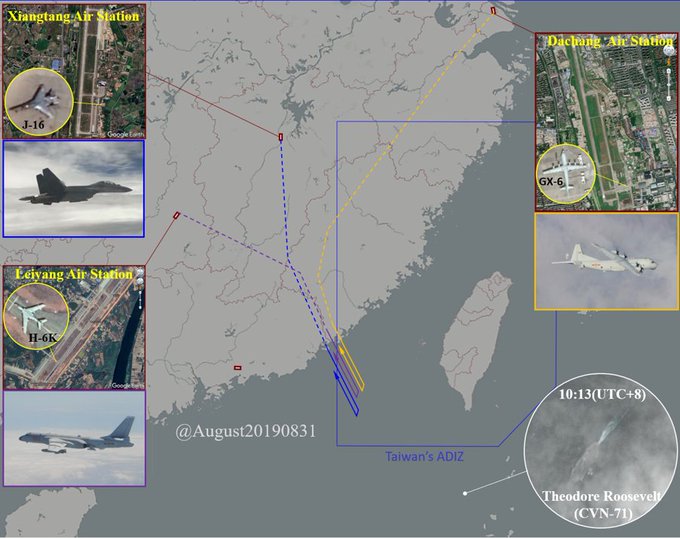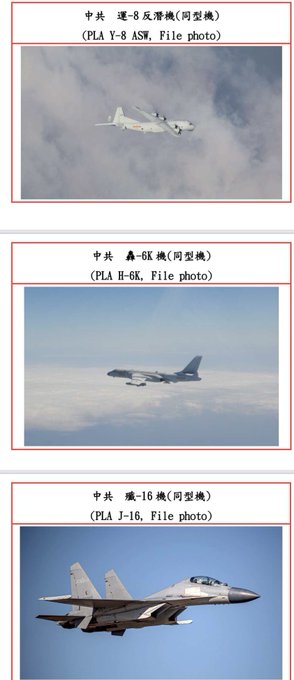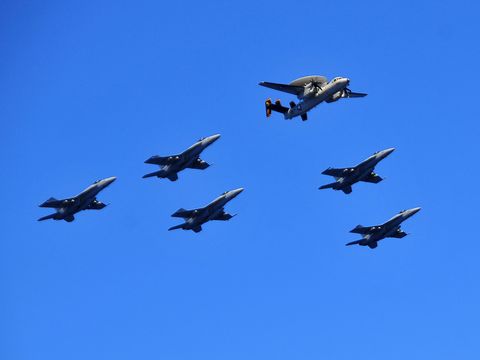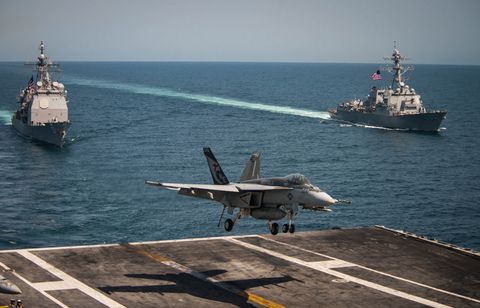

Xi Jinping orders China’s military to be ready for war ‘at any time’
CHINA
Soldiers of the Chinese People’s Liberation Army (Chairman of the Joint Chiefs of
Staff/WikiCommons)
JANUARY 06, 2021 RYAN MORGAN
On Monday, Chinese leader Xi Jinping ordered
China’s military to mobilize in 2021 for “full-time combat readiness,” stressing a need to be ready for war at “any time.”A readout of Xi’s order, posted on China’s Central Military Command (CMC) website, urged the People’s Liberation Army (PLA) and People’s Armed Police Force (PAPF) to focus on preparing for combat. The South China Morning Post reported the 2021 mobilization order is a departure from last year’s mobilization order, in which Xi instructed China’s armed forces to “manage crises and deter war.”
The CMC readout of the 2021 mobilization order states, “Training under real combat conditions must be deepened and all military training should be warcentered and conducive to improving combat effectiveness, and the research on warfare and combat-related issues should be enhanced.”
The order also asks China’s armed forces to train for confrontation under real war scenarios, to “hone the troops in the frontline of military struggle, and promote the in-depth combination and integration of military training and operations, ensuring combat readiness all the time and operational capability at any time.”
The order does not specify the frontline military struggle Chinese troops faced. While China is not
formally in a state of war or armed conflict with other nations, Chinese troops were involved in a brawl with Indian troops along a disputed border region in 2020.The fighting resulted in the deaths of 20 Indian troops and an undisclosed number of Chinese casualties.
Xi’s new mobilization order further emphasized the need for joint training between different military commands, “Stressing that the military should highlight multi-domain joint training involving multiple services and arms and military-civil joint training, and develop a joint training system with the Chinese military’s characteristics.”
The 2021 mobilization effort comes as China has increasingly prepared to control the contested South China Sea region, despite the U.S. rejecting China’s territorial claims in the region. China has also alluded to conflict with the U.S., in one instance releasing a military recruitment ad depicting Chinese bombers dropping bombs on the U.S. territory of Guam.
Xi has directed China’s military to become a modern fighting force. A September Pentagon report said China is working to modernize its military theory by 2035 and to fully transform China’s military units into “world-class” forces by 2049. Increasing joint perations between Chinese military commands would serve to train its forces for modern military fights across different domains.
The new order also calls for China’s armed forces to increasingly integrate new technology.
“The idea of science and technology being a core combat capability should be consolidated, and
training with new armaments and new forces in new domains be strengthened and incorporated in
training of operational systems,” the readout states.
Xi’s order concludes by calling on Chinese troops to “carry forward the fighting spirit of fearlessness to hardships and death, strengthen their willpower, improve their skills, and accomplish the missions and tasks entrusted by the [Chinese Communist Party] and the people in the new era.”

South China Sea tension flares again as Biden takes charge
China has complained about US vessels in the South China Sea close to islands it controls or claimsA US aircra carrier group led by the USS Theodore Roosevelt entered the South China Sea over the weekend to promote “freedom of the seas” at a time of US concern about China-Taiwan tensions and Beijing asserting its maritime agenda.
Taiwan, meanwhile, reported an incursion of Chinese bombers and fighter jets into its air defence identification zone.
The patrol comes just days after Joe Biden was sworn in as US president and follows a year of repeated demonstrations of military power by both Beijing and Washington.
China has complained about US vessels in the South China Sea close to islands it controls, claims, or constructed and turned into military installations.
The Trump and Obama administrations carried out such patrols regularly, ostensibly to challenge China’s “nine-dash line” claim to jurisdiction over almost the entire South China Sea, which an international arbitral tribunal ruled has no legal basis.
The US Indo-Pacific Command said Saturday’s patrol was to “ensure freedom of the seas, (and) build partnerships that foster maritime security” suggesting Biden, as with the “pivot” strategy of the Obama administration he served as vice president, will pursue deeper engagement and alliancebuilding in Southeast Asia, to try to prevent China establishing regional hegemony.
Troubled waters
Malaysia, Vietnam, the Philippines and Brunei, as well as Taiwan, have territorial claims in the waterway and largely welcome the US presence, mainly as a check on China’s militarisation and its vast coastguard and fishing fleet.
Southeast Asian countries last year expressed worry that the escalating US-China tensions could lead to military confrontation, with potential for big disruptions to a vital trade route, which would have devastating consequences for their economies.
The United States has accused China of bullying and attempting to build a “maritime empire”, announcing several rounds of sanctions on Chinese state companies involved in building artificial islands.
China sees the United States as an outsider interfering in a region in which it sees itself as a force for peace and stability.
“It’s business as usual for strategic competition,” said Renato de Castro, a defence expert at Manila’s
De La Salle University, adding the US patrol was “both reassuring and concerning”.
“The Biden administration cannot show weakness in foreign policy,” he added.
Tensions have risen as a result of what the United States saw as underhanded tactics by China to advance its territorial claims while its neighbours were fighting coronavirus epidemics.
Vietnam and the Philippines have protested China’s establishment of administrative districts in the disputed Paracel islands and in the Spratly islands. Protests also followed China’s military drills near the Paracels, including the firing of ballistic missiles from several locations into waters nearby.
Chinese coastguard and survey vessels were repeatedly tracked in 2020 near energy exploration in offshore plots operated by Malaysia and Vietnam, disrupting activities and leading to weeks-long standoffs.
Trouble ahead?
Though not directly linked, the US patrol came a day after China passed a law allowing its coastguard to open fire on foreign vessels. That could increase the risk of conflict given the competing territorial claims and the vast distances travelled by China’s coastguard fleet.
The bill, which China says is in line with international practices, also allows coastguard personnel to
demolish other countries’ structures on reefs it claims, and to board and inspect foreign vessels in China-claimed waters.
“The law heightens the risk of inducing unintended incidents at sea,” said Ha Hoang Hop, a fellow at Singapore’s ISEAS–Yusof Ishak Institute, adding it could also be considered a warning to Washington.
Several analysts expect the United States to continue the patrols and firm up relations with littoral states, and for China to increase military exercises and disrupt any efforts to resume energy activities in waters it considers its own.
 spacer
spacerChina: US military presence in South China Sea a threat to peace, stability

Beijing criticises US military presence in South China Sea …
spacer
A version of this article appeared in the print edition of The Straits Times on January 26, 2021, with the headline ‘Beijing criticises US military presence in South China Sea’.
spacer
China deploys warships in South China Sea after US …spacer
January 26, 2021 A US aircraft carrier group sailed into the South China Sea on a so-called “freedom of navigation” exercise, the first routine operation in the region under new President Joe Biden.
spacer
US stresses South China Sea support amid China ‘pressure …
spacer
January 28, 2021 Secretary of State Antony Blinken has reaffirmed the United States commitment to the support of Southeast Asian nations in a long-running dispute with China over sovereignty in the South China Sea….
spacer
spacer
US slams China for ‘destabilising’ actions in South China Sea

TAIPEI (Reuters) – A U.S. aircraft carrier group led by the USS Theodore Roosevelt has entered the South China Sea to promote “freedom of the seas”, the U.S. military said on Sunday, at a time when tensions between China and Taiwan have raised concern in Washington.
U.S. Indo-Pacific Command said in a statement the strike group entered the South China Sea on Saturday, the same day Taiwan reported a large incursion of Chinese bombers and fighter jets into its air defence identification zone in the vicinity of the Pratas Islands.
The U.S. military said the carrier strike group was in the South China Sea, a large part of which is claimed by China, to conduct routine operations “to ensure freedom of the seas, build partnerships that foster maritime security”.
“After sailing through these waters throughout my 30-year career, it’s great to be in the South China Sea again, conducting routine operations, promoting freedom of the seas, and reassuring allies and partners,” Rear Adm. Doug Verissimo, commander of the strike group, was quoted as saying.
“With two-thirds of the world’s trade travelling through this very important region, it is vital that we maintain our presence and continue to promote the rules-based order which has allowed us all to prosper,” Verissimo said in the statement.
The announcement comes just days after Joe Biden was sworn in as U.S. president.
China has repeatedly complained about U.S. Navy ships getting close to Chinese-occupied islands in the South China Sea, where Vietnam, Malaysia, the Philippines, Brunei and Taiwan all have competing claims.
The Theodore Roosevelt is being accompanied by the Ticonderoga-class guided-missile cruiser USS Bunker Hill, and the Arleigh Burke-class guided-missile destroyers USS Russell and USS John Finn, the U.S. statement said.
Reporting by Ben Blanchard; Editing by Tom Hogue
Our Standards: The Thomson Reuters Trust Princi
spacer
spacer
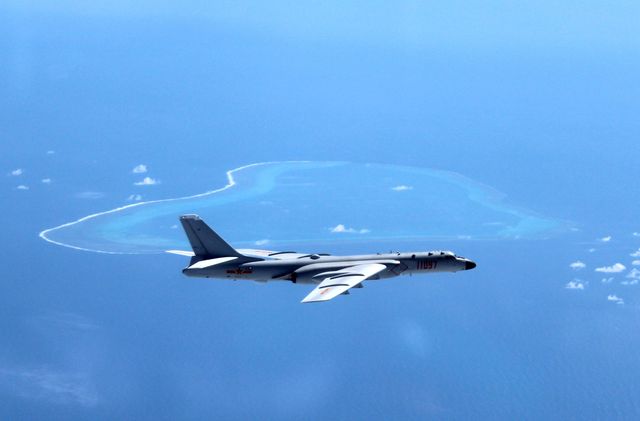
XINHUA NEWS AGENCYGETTY IMAGES
- A recent Chinese military exercise in the South China Sea turned out to be far more provocative than originally reported.
- A large force of Chinese Air Force bombers flew into the South China Sea at the same time a U.S. Navy carrier was in the area.
- The bombers reportedly carried out a simulated attack on the carrier, practicing an attempt to sink it.
A recent Chinese show of force in the South China Sea, practiced at the same time a U.S. aircraft carrier was operating in the area, was far more aggressive than originally believed. Eight Chinese Air Force bombers flying near the USS Theodore Roosevelt weren’t just responding to the carrier’s presence in China’s backyard—they were actually rehearsing an attack on the carrier task force.
This content is imported from Twitter. You may be able to find the same content in another format, or you may be able to find more information, at their web site.
Tweet
Quote Tweet
國防部 Ministry of National Defense, R.O.C.
@MoNDefense·Thirteen PLA aircraft (Y-8 ASW*1、H-6K*8、J-16*4) entered #Taiwan’s southwest ADIZ on Jan. 23, 2021. Please check our official website for more information: bit.ly/2KE1BwK
The incident took place on January 23, three days after President Joe Biden’s inauguration. The USS Theodore Roosevelt carrier strike group entered the South China Sea through the Bashi Strait, sailing between Taiwan and the Philippines.
Around the same time, eight People’s Liberation Army Air Force H-6K bombers, accompanied by four J-16 fighters and a Y-8 anti-submarine warfare aircraft, took off from airfields on China’s central coast and headed south. Their course, as the map embedded in the tweet above shows, would have put them on course to intercept any ships sailing through the Bash Strait.
This content is imported from {embed-name}. You may be able to find the same content in another format, or you may be able to find more information, at their web site.When Popular Mechanics covered the incident last week, we pointed out the H-6 bombers can carry up to six land attack cruise missiles each. The Financial Times, however, reports the bombers were actually drilling to attack the Theodore Roosevelt itself:
People familiar with intelligence said the bombers and some of the fighter aircraft involved were conducting an exercise that used the USS Theodore Roosevelt carrier strike group. One person familiar with the incident said the Chinese aircraft remained more than 250 nautical miles from the US carrier and accompanying warships at all times.
Pilots of H-6 bombers could be heard in cockpit conversations confirming orders for the simulated targeting and release of anti-ship missiles against the carrier, the people said.
The 13 Chinese military aircraft involved in the incident represent an anti-carrier strike package. The eight H-6 bombers were the “shooters” meant to target the Roosevelt. The bombers would have practiced launching a missile like the YJ-12 anti-ship missile, a large anti-ship missile with a top speed of Mach 3 to 4 and a range of 248 miles. The Aviationist says each H-6 can carry up to six YJ-12 missiles, for a theoretical total of 48 anti-ship missiles on this mission alone.
The four J-16 fighters were escorts tasked with protecting the bombers. The Y-8 anti-submarine aircraft may sound like a curious inclusion, but the unarmed sub hunter’s surface search radar would have made it a useful scout for locating the carrier strike group at sea.
Last week’s bomber sortie was a dangerous escalation in U.S. and Chinese military encounters. The U.S. and Russia routinely fly bombers near each other’s borders, but limit the number of planes to two or less. Flying one or two bombers is militarily useless, and both sides recognize it as more of a trolling exercise than anything else. But flying eight bombers—with pilots practicing orders to launch missiles—goes beyond trolling and enters the realm of a feasible military mission.
The Chinese did hold back a little bit during the exercise; the range of the missiles, and the distance the bombers kept from the carrier strike group, meant the bombers didn’t actually come close to firing range. Still, that’s not much comfort, considering the bombers actually practiced an attack.
If the mission was real, could the carrier strike group have protected itself? The YJ-12 is a formidable missile, but the carrier and its escorts would have proven a tough nut to crack.
First, the carrier would have a round-the-clock combat air patrol protecting the ship, consisting of Super Hornet strike fighters and an E-2D Hawkeye airborne early warning and control plane. The E-2D’s radar would pick up the non-stealthy Chinese aircraft at a distance of hundreds of miles and send a greeting party of Super Hornets to intercept. Each carrier embarks between 40 and 44 Super Hornet strike fighters on a typical patrol.
In most cases, that would probably be the end of it, as the better-trained and -equipped American fighters quickly shoot down the Chinese strike package. But for the sake of argument, let’s assume the H-6 bombers managed to launch their missiles.
Now, the carrier and its 6,000 sailors and aircrew are in real danger. The YJ-12 is reportedly a sea-skimming missile, meaning it flies close to the surface of the ocean in order to evade radar. A radar can only see line of sight, and the curvature of Earth limits a ground-based radar’s ability to detect low-flying targets.
Although the missile has a 250-mile range, the YJ-12’s low cruising altitude means the incoming swarm of missiles may not be detectable until 25 miles or less. The missiles, flying at Mach 3 or 4, can close that distance in less than one minute.
Under normal circumstances, the carrier’s escorts, which typically include a guided missile cruiser and two or more destroyers, would have just seconds to shoot down any Chinese missiles. The U.S. Navy’s new cooperative engagement capability (CEC) now means an E-2D Hawkeye, cruising at high altitude, can look down and track the YJ-12s and pass targeting data to the carrier’s escorts, allowing them to shoot the incoming missiles down at much greater distances.
spacer
IT’S ON THE WALL, BUT WILL WE LISTEN?
Link to rhe video on Marfoogle News Youtube: https://www.youtube.com/watch?v=UqloVi749CU&feature=youtu.be
spacer

 Tweet
Tweet
